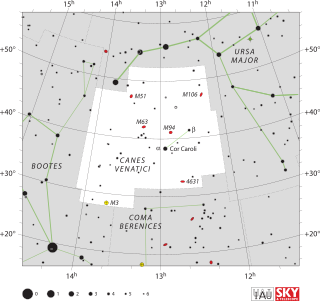
Canes Venatici is one of the 88 official modern constellations. It is a small northern constellation that was created by Johannes Hevelius in the 17th century. Its name is Latin for 'hunting dogs', and the constellation is often depicted in illustrations as representing the dogs of Boötes the Herdsman, a neighboring constellation.

Sagittarius is one of the constellations of the zodiac and is located in the Southern celestial hemisphere. It is one of the 48 constellations listed by the 2nd-century astronomer Ptolemy and remains one of the 88 modern constellations. Its name is Latin for "archer", and its symbol is , a stylized arrow. Sagittarius is commonly represented as a centaur pulling back a bow. It lies between Scorpius and Ophiuchus to the west and Capricornus and Microscopium to the east.

The Jewel Box is an open cluster in the constellation Crux, originally discovered by Nicolas Louis de Lacaille in 1751–1752. This cluster was later named the Jewel Box by John Herschel when he described its telescopic appearance as "...a superb piece of fancy jewellery". It is easily visible to the naked eye as a hazy star some 1.0° southeast of the first-magnitude star Mimosa. This hazy star was given the Bayer star designation "Kappa Crucis", from which the cluster takes one of its common names. The modern designation Kappa Crucis has been assigned to one of the stars in the base of the A-shaped asterism of the cluster

Messier 22 or M22, also known as NGC 6656, is an elliptical globular cluster of stars in the constellation Sagittarius, near the Galactic bulge region. It is one of the brightest globulars visible in the night sky. The brightest stars are 11th magnitude, with hundreds of stars bright enough to resolve with an 8" telescope. It is just south of the sun's position in mid-December, and northwest of Lambda Sagittarii, the northernmost star of the "Teapot" asterism.

The Small Sagittarius Star Cloud is a star cloud in the constellation of Sagittarius, approximately 600 light years wide, which was discovered by Charles Messier in 1764. It should not be confused with the nearby Large Sagittarius Star Cloud which lies about 10° to the south.

Messier 28 or M28, also known as NGC 6626, is a globular cluster of stars in the center-west of Sagittarius. It was discovered by French astronomer Charles Messier in 1764. He briefly described it as a "nebula containing no star... round, seen with difficulty in 31⁄2-foot telescope; Diam 2′."

In observational astronomy, an asterism is a popularly-known pattern or group of stars that can be seen in the night sky. This colloquial definition makes it appear quite similar to a constellation, but they differ in that a constellation is a formally-named area of the sky and all the celestial objects within it, representing an object, person, or animal, often mythological; while an asterism is a visually obvious collection of stars and the lines used to mentally connect them. As such, asterisms do not have officially determined boundaries and are therefore a more general concept which may refer to any identified pattern of stars. This distinction between terms remains somewhat inconsistent, varying among published sources. An asterism may be understood as an informal group of stars within the area of an official or defunct former constellation, or crossing the boundaries of two or more constellations.
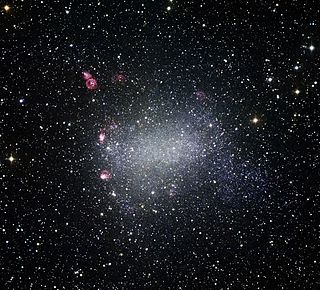
NGC 6822 is a barred irregular galaxy approximately 1.6 million light-years away in the constellation Sagittarius. Part of the Local Group of galaxies, it was discovered by E. E. Barnard in 1884, with a six-inch refractor telescope. It is one of the closer galaxies to the Milky Way. It is similar in structure and composition to the Small Magellanic Cloud. It is about 7,000 light-years in diameter.
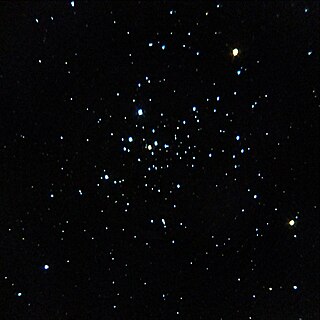
NGC 2516 is an open star cluster in the southern sky in the constellation Carina discovered by Abbe Lacaille in 1751-1752. It is also called Southern Beehive or the Sprinter.

NGC 6578 is a planetary nebula located in Sagittarius. It is magnitude 13.5 with diameter 8 arc seconds. It has a 16th magnitude central star. It is seen near the star 16 Sagittarii.
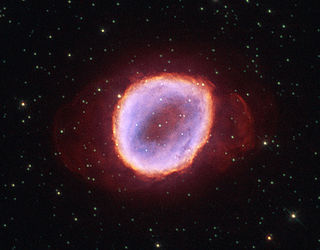
NGC 6565, also known as ESO 456-70, is a planetary nebula 14,000 light-years away, formed when a star ejected its outer layers during the late stages of its evolution.. It is about 13th magnitude and has a diameter of 8 to 10 arcseconds. It is located in the constellation Sagittarius.
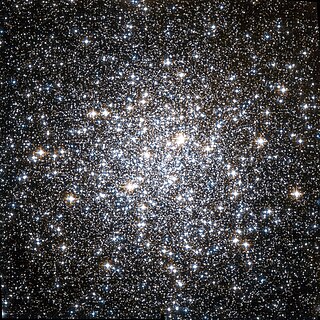
NGC 6723 is a globular cluster in the constellation Sagittarius. Its magnitude is given as between 6 and 6.8, and its diameter is between 7 and 11 arcminutes. It is a class VII cluster with stars of magnitude 14 and dimmer. It is near the border of Sagittarius and Corona Australis.

The Little Gem Nebula or NGC 6818 is a planetary nebula located in the constellation of Sagittarius. It has magnitude 10 and oval diameter of 15 to 22 arcseconds with a 15th magnitude central star.

NGC 6530 is an open cluster in the constellation Sagittarius. It has a diameter of 10 arc minutes, with stars as bright as 7th magnitude. It exists within nebula Messier 8, the Lagoon Nebula.
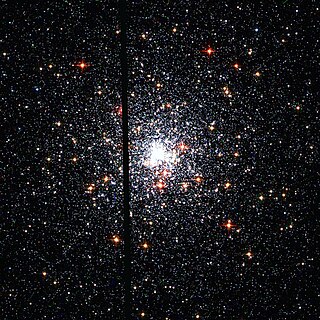
NGC 6624 is a globular cluster in the constellation Sagittarius. It was discovered on 24 June 1784 by the astronomer William Herschel. It is given an apparent magnitude of 7.6 to 8.5. Six pulsars are known in NGC 6624. The first of these to be discovered was PSR J1823-3021A. This globular cluster also contains 4U 1820-30, a low-mass X-ray binary with an orbital period of only 11.5 minutes.
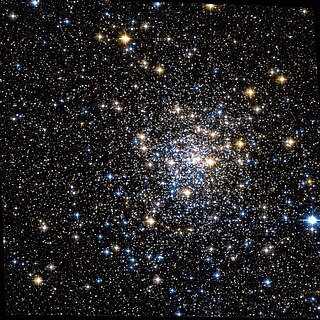
NGC 6544 is a small globular cluster visible in the constellation Sagittarius. It is magnitude 7.5, diameter 1 arc minute. It is less than 1 degree southeast of Messier 8, the lagoon nebula.
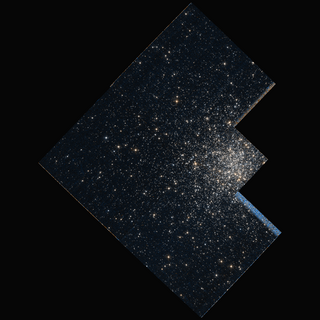
NGC 6638 is a globular cluster in the constellation Sagittarius. It is magnitude 9.5 and diameter 2 arc minutes, class VI. It is a half degree East of Lambda Sagittarii.
NGC 6540 is a globular cluster in the constellation Sagittarius. Its apparent magnitude is 9.3 and its diameter is about 9.5 arcminutes, with 12 faint stars visible. It is about 17,000 light years away from Earth and was discovered by Wilhelm Herschel on May 24, 1784 with an 18.7-inch mirror telescope, who described the cluster as "pretty faint, not large, crookedly extended, easily resolvable".

NGC 6528 is a globular cluster in the constellation Sagittarius, and is listed in the New General Catalogue. It has an apparent magnitude of about 11 and a diameter of about 16 arcminutes, and its Shapley-Sawyer Concentration Class is V, containing stars of 16th magnitude and dimmer. Dreyer described it as "pF, cS, R", meaning poor and faint, considerably small and round.

The Large Sagittarius Star Cloud is the brightest visible region of the Milky Way, a portion of the central bulge of the Galaxy seen around the thick dust of the Great Rift, which lines the northwest edge. It should not be confused with the nearby Small Sagittarius Star Cloud, which lies about 10° to the north. The star cloud stretches several degrees north from the star Gamma Sagittarii and is considered a splendid sight in binoculars - "a bright glow with multitudes of momentarily resolved star-sparks". To the naked eye, the Cloud appears bright and smooth, and is said to resemble a puff of "steam" escaping from the spout of the Sagittarius "Teapot" asterism.




















